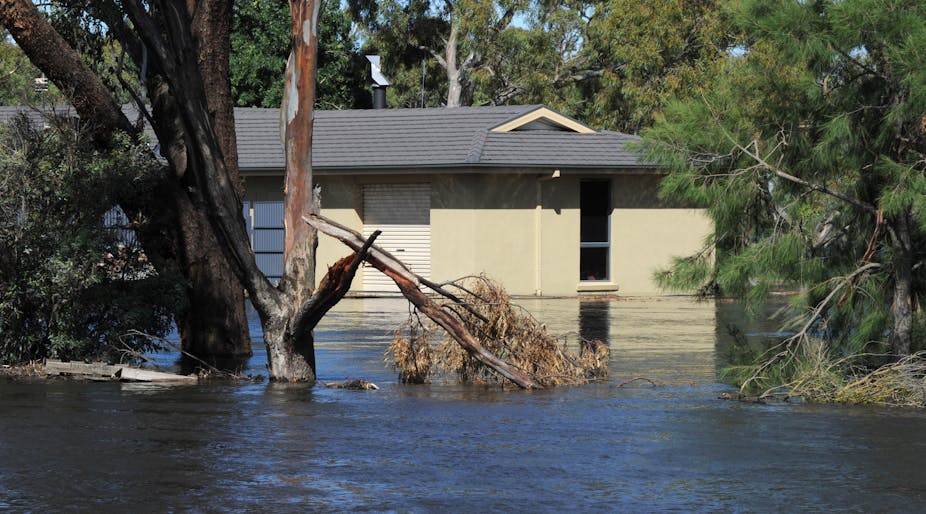It’s inescapable that when it rains a lot, floods occur.
These events are largely beyond our control. We have to live with them, rather than live in the hope that we can eliminate them. And by using buy backs, we can get out of their way.
The long-term costs of natural disasters in Australia are huge. The Australian Bureau of Statistics has estimated that natural disasters cost us more than $1 billion per year.
The largest component of this comes from flood damage, which accounts for $314 million in damages annually.
This says nothing of recent extreme flooding, the costs of which are estimated at tens of billions of dollars.
There is clearly potential for a large return on investment here.
Don’t fight the floods
While the recent floods have reminded us that there are many farms, homes and towns on flood-prone land, this is not new information.
We knew before the recent floods that there was significant flood-prone land across eastern Australia yet we continue to place high value assets in the path of floods.
The technical task of estimating flood risk is routine, we are good at it and we have good information for many (but not all) areas.
By planning better, we can significantly mitigate flood damage (as opposed to mitigating the flood) and reduce community disruption at the same time.
Flood considerations can be easily incorporated in future developments, but fixing the mistakes of the past is harder, because inappropriate land uses are already established. Challenges arise particularly where land is in private hands.
The Victorian Government’s proposal to buy back flood-prone land provides an opportunity to fix some past mistakes, provided it is targeted well.
The scheme will enable land titles to be reconfigured, with some floodways retained in public ownership and other areas leased or resold with covenants restricting landuses.
This is a sound approach in principle because it can enable a move to more risk-attuned use of land.
The scale of the challenge
But before considering buy backs in more detail, it’s important to gain some appreciation of the scale of the challenge.
The lower Loddon Floodplain around Kerang and Benjeroop, the area targeted for current buy backs, is a large area of flood-prone land – 20km or more across in places and thousands of square kilometres in extent.
The lower Loddon is not unique in the extent of likely flooding – many of the rivers flowing across the Riverine plains of the Murray-Darling basin are similarly prone, as are other rivers.
Much of this flood plain (both farms and towns) is in private hands. The current proposal to buy back land on the Lower Loddon Flood Plain could be a good pilot, but the current budget will not make a significant dent in the problem.
Buy backs should be based on reliable estimates of probable flood damages. This is a combination of flood risk (the probability of a certain flood occurring) and the value and type of assets that will be affected by any flooding.
Recent flooding is not necessarily a good indicator of future flood damage probability because big floods are low probability events.
This principle is likely to be at odds with the political imperatives of flood response. This is a significant risk to maximising the value of the public investment.
We should be acting before the next flood, not after it. Many buy back schemes are reactive rather than proactive.
To be effective, buy backs need to be guided by comprehensive floodplain strategies that ensure passage of floodwater through the system without exacerbating either upstream or downstream flooding.
Intact floodway routes must be re-established where they have been broken and any remaining flood protection measures such as levees need to be strategically relocated.
Many of our flood plains are extremely flat and embankments (roads, levees, etc) can influence water levels kilometres upstream. Without a whole-of-flood plain view we invite problems such as water being trapped behind levees, which was a significant problem in some areas in the recent Victorian floods.
Buying back and protecting the public purse
We must develop a comprehensive floodplain strategy to maximise societal benefits of buying back flood-prone land.
Many agricultural activities can be appropriate on some areas of flood plains, but only if farmers understand flood risks so they can make informed decisions. There is a gradation of risk across the flood plain that needs to be accounted for in this decision making.
But other uses, particularly the construction of buildings, should be excluded from higher risk areas.
Where people take informed risks, insulating the public purse from those risks is important and needs careful consideration.
An important complementary consideration is that flood damage can be more effectively mitigated through the provision of information on land and water levels.
This can help landowners identify low risk areas for the temporary or permanent relocation of livestock, infrastructure and machinery.
Lest we forget
We need to maintain people’s understanding of flood risk and how to effectively respond to flood events.
Big floods are typically many years apart and community memory wanes. People forget, they move on, newcomers move in.
Associating clear flood risk information with land title is beneficial when land transactions occur because it adds transparency to the transaction.
However, other efforts will be required to maintain the community’s understanding of how to respond next time it rains a lot.
Overall, the flood prone-land buy back program scheme proposed by the Victorian Government is promising but there are many pitfalls along the way.
But as the events of last summer have shown, it’s essential we get it right.

